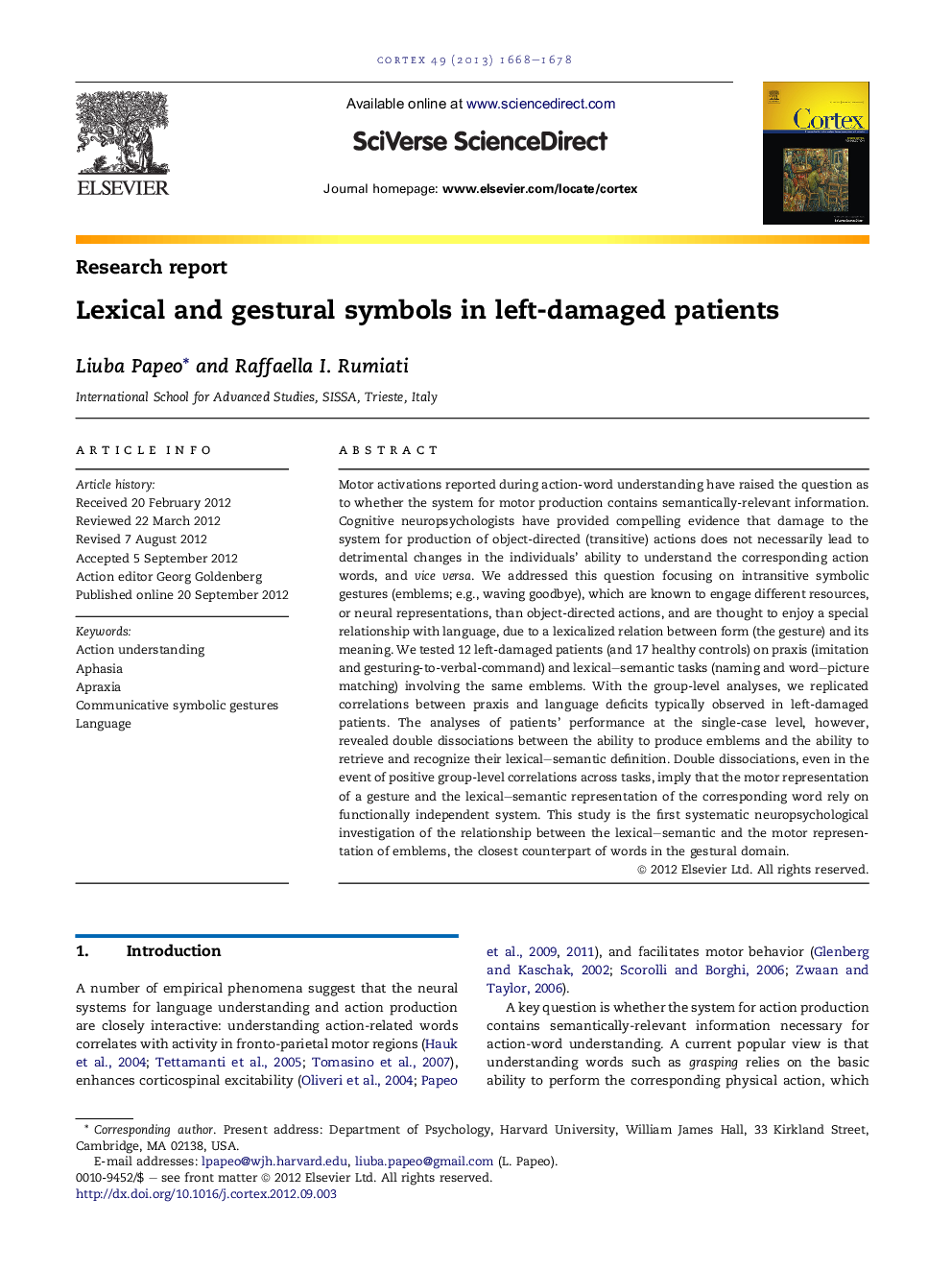| کد مقاله | کد نشریه | سال انتشار | مقاله انگلیسی | نسخه تمام متن |
|---|---|---|---|---|
| 10463120 | 925104 | 2013 | 11 صفحه PDF | دانلود رایگان |
عنوان انگلیسی مقاله ISI
Lexical and gestural symbols in left-damaged patients
ترجمه فارسی عنوان
علائم لکسی و ژست در بیماران مبتلا به چپ
دانلود مقاله + سفارش ترجمه
دانلود مقاله ISI انگلیسی
رایگان برای ایرانیان
کلمات کلیدی
درک عملی افساسی، آپاکسیا، حرکات نماد ارتباطی، زبان،
ترجمه چکیده
فعال سازی موتور در جریان درک عملی کلمه گزارش شده است که آیا این سیستم برای تولید موتور شامل اطلاعات مربوط به معنایی است. عصب شناسان شناختی مدارک قانع کننده ای ارائه داده اند که آسیب به سیستم برای تولید اقدامات حرکتی (حرکتی) لزوما منجر به تغییرات مضر در توانایی افراد در درک واژگان مربوطه و برعکس نمی شود. ما این سوال را با توجه به حرکات نمادین غیرمستقیم (علامت ها، به عنوان مثال، گمراه کردن خداحافظ)، که شناخته شده است به منابع مختلف و یا بازنمایی های عصبی، نسبت به اقدامات شیئی هدایت شده، مورد توجه قرار داده اند، و به نظر می رسد که از یک رابطه ویژه با زبان به دلیل یک رابطه لفظی بین فرم (ژست) و معنای آن. ما 12 بیمار مبتلا به چپ (و 17 کنترل سالم) را بر روی پراکسیس (تقلید و فرمان ژستو به قاعده) و کارهای واژگانی-معناشناختی (نامگذاری و تطبیق کلمه-تصویر) با همان نشانهها مورد آزمایش قرار دادیم. با تجزیه و تحلیل سطح گروه، ما همبستگی بین پراکسیس و نقص زبان که معمولا در بیماران مبتلا به چپ دیده می شود، تکرار کردیم. با این حال، تجزیه و تحلیل عملکرد بیماران در سطح یکپارچه، نشان دهنده اختلاف دوگانه بین توانایی تولید علائم و توانایی تشخیص واژنی و معنایی آنها بود. تقسیم دوگانه، حتی در صورت همبستگی مثبت در سطح گروه در میان وظایف، حاکی از این است که نمایش موتور از یک ژست و نمایش لفظی-معنایی کلمه متناظر به سیستم مستقل عمل می کند. این مطالعه اولین بررسی سیستماتیک عصب روانشناختی ارتباط بین نشانه واژگان-معنایی و نمایندگی موتور از نشان ها، نزدیک ترین علامت از کلمات در دامنه ژست است.
موضوعات مرتبط
علوم زیستی و بیوفناوری
علم عصب شناسی
علوم اعصاب رفتاری
چکیده انگلیسی
Motor activations reported during action-word understanding have raised the question as to whether the system for motor production contains semantically-relevant information. Cognitive neuropsychologists have provided compelling evidence that damage to the system for production of object-directed (transitive) actions does not necessarily lead to detrimental changes in the individuals' ability to understand the corresponding action words, and vice versa. We addressed this question focusing on intransitive symbolic gestures (emblems; e.g., waving goodbye), which are known to engage different resources, or neural representations, than object-directed actions, and are thought to enjoy a special relationship with language, due to a lexicalized relation between form (the gesture) and its meaning. We tested 12 left-damaged patients (and 17 healthy controls) on praxis (imitation and gesturing-to-verbal-command) and lexical-semantic tasks (naming and word-picture matching) involving the same emblems. With the group-level analyses, we replicated correlations between praxis and language deficits typically observed in left-damaged patients. The analyses of patients' performance at the single-case level, however, revealed double dissociations between the ability to produce emblems and the ability to retrieve and recognize their lexical-semantic definition. Double dissociations, even in the event of positive group-level correlations across tasks, imply that the motor representation of a gesture and the lexical-semantic representation of the corresponding word rely on functionally independent system. This study is the first systematic neuropsychological investigation of the relationship between the lexical-semantic and the motor representation of emblems, the closest counterpart of words in the gestural domain.
ناشر
Database: Elsevier - ScienceDirect (ساینس دایرکت)
Journal: Cortex - Volume 49, Issue 6, June 2013, Pages 1668-1678
Journal: Cortex - Volume 49, Issue 6, June 2013, Pages 1668-1678
نویسندگان
Liuba Papeo, Raffaella I. Rumiati,
